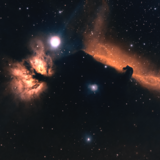×
INDI Library v2.0.7 is Released (01 Apr 2024)
Bi-monthly release with minor bug fixes and improvements
Guiding with dithering question - amount of pixels for dithering?
- Juergen Terpe
-
 Topic Author
Topic Author
- Offline
- Junior Member
-

- Posts: 36
- Thank you received: 3
Hello everyone,
I would like to ask for a better understanding of dithering, especially the dither radius in pixels, see here:
Hello everyone,
I would like to ask for a better understanding of dithering, especially the dither radius in pixels, see here:
The dither radius is set to 2 pixels per default and the shown tooltip says: "Number of pixels to move the guiding square in a random direction." Okay, from my understanding this means the square inside the captured image of the guiding camera is moved and the guiding algorithm will correct this in a way the star will be centered again in the square. Obviously at the first sight, there should be no misunderstanding.
Now the two things which I find confusing.
1.) When using 2x2 binning: Is the square now moved to just one pixel (is the binning itself considered)? I would expect: yes. However, it would be also correct if still 2 pixels are used for the dither radius.
2.) Now comes the tricky part. Sometimes I'm capturing with a primary scope of 600mm focal length and I'm using a guiding scope with 240mm focal length. Not to forget the different chip sizes. Alltogether, when the 2 pixels are measured from inside the guiding image, it will be less in my final image (I did change it to 5px, maybe not enough but I'm not willing to do the math for this - a good rule of thumb is okay here, so maybe 10px will be really good then). However, I'm also using my primary scope with 600mm and the ZWO ASI 120mm Mini for guiding and use a 200mm or 300mm lens on my Canon for capturing. Now I have a much wider field in my captured image and a very small guiding image. 2 Pixels or even 10 Pixels here will be less than a pixel on my captured image. In this case I would need to set it to perhaps 20px or more.
Are my expectations and thoughts correct? What do you use for a value of the dither radius in pixels? Yes, I'm able to calculate this my self as a simple relation based on the focal lengths and chip sizes as a ratio to calculate the factors to find a good minimal value for this radius. However, what's confusing me: Ekos knows my primary scope and guiding scope relation, because I need to set it up in order to get many other things to work. So could it be, that just the tooltip is not a good explanation of this value and the 2px default value already is related to my captured image? The downside of this is that perhaps a to large dither radius could introduce new issues when the guiding continues - maybe many stars are already outside the image, especially when the stars are automatically selected?
Maybe, I'm just too curious about how the things work and it just works, so I should not spend time on such things. However, using the camera lens the captured images have just no noticable black frames at the borders, meaning they cannot be dithered by a large amount - and they look not like a dithered image should look after stacking.
So any thoughts are welcome.
Regards,
Jürgen
I would like to ask for a better understanding of dithering, especially the dither radius in pixels, see here:
Hello everyone,
I would like to ask for a better understanding of dithering, especially the dither radius in pixels, see here:
The dither radius is set to 2 pixels per default and the shown tooltip says: "Number of pixels to move the guiding square in a random direction." Okay, from my understanding this means the square inside the captured image of the guiding camera is moved and the guiding algorithm will correct this in a way the star will be centered again in the square. Obviously at the first sight, there should be no misunderstanding.
Now the two things which I find confusing.
1.) When using 2x2 binning: Is the square now moved to just one pixel (is the binning itself considered)? I would expect: yes. However, it would be also correct if still 2 pixels are used for the dither radius.
2.) Now comes the tricky part. Sometimes I'm capturing with a primary scope of 600mm focal length and I'm using a guiding scope with 240mm focal length. Not to forget the different chip sizes. Alltogether, when the 2 pixels are measured from inside the guiding image, it will be less in my final image (I did change it to 5px, maybe not enough but I'm not willing to do the math for this - a good rule of thumb is okay here, so maybe 10px will be really good then). However, I'm also using my primary scope with 600mm and the ZWO ASI 120mm Mini for guiding and use a 200mm or 300mm lens on my Canon for capturing. Now I have a much wider field in my captured image and a very small guiding image. 2 Pixels or even 10 Pixels here will be less than a pixel on my captured image. In this case I would need to set it to perhaps 20px or more.
Are my expectations and thoughts correct? What do you use for a value of the dither radius in pixels? Yes, I'm able to calculate this my self as a simple relation based on the focal lengths and chip sizes as a ratio to calculate the factors to find a good minimal value for this radius. However, what's confusing me: Ekos knows my primary scope and guiding scope relation, because I need to set it up in order to get many other things to work. So could it be, that just the tooltip is not a good explanation of this value and the 2px default value already is related to my captured image? The downside of this is that perhaps a to large dither radius could introduce new issues when the guiding continues - maybe many stars are already outside the image, especially when the stars are automatically selected?
Maybe, I'm just too curious about how the things work and it just works, so I should not spend time on such things. However, using the camera lens the captured images have just no noticable black frames at the borders, meaning they cannot be dithered by a large amount - and they look not like a dithered image should look after stacking.
So any thoughts are welcome.
Regards,
Jürgen
2 years 8 months ago
#74173
Attachments:
Please Log in or Create an account to join the conversation.
- Kevin Ross
-

- Offline
- Elite Member
-

- Posts: 421
- Thank you received: 102
Replied by Kevin Ross on topic Guiding with dithering question - amount of pixels for dithering?
Back when I used a DSLR for imaging (either a Canon 500D, 7D, or 7D Mk II), I always set the dither to the maximum (10 pixels). DSLRs really benefit from large dithers, because of the fixed pattern noise (banding). And there is also some blocky chunks of noise that also benefit from large dithers. 10 worked well. You also want to dither after every image.
Now that I have a proper astro camera, the default of 2 pixels is perfectly adequate, for me anyway.
BTW, you'll want to check the "only start if guide deviation is < xxx arcsec" on the capture tab. That will wait for the guiding to settle before it starts to capture each image. The settle parameters on the guiding options tab have no effect, they are only used when using PHD2 guiding (at least that's what I've heard, and matches my observation). But the "only start if guide deviation" checkbox on the capture tab does work, and it will wait after every dither before starting to capture. Works quite well.
Now that I have a proper astro camera, the default of 2 pixels is perfectly adequate, for me anyway.
BTW, you'll want to check the "only start if guide deviation is < xxx arcsec" on the capture tab. That will wait for the guiding to settle before it starts to capture each image. The settle parameters on the guiding options tab have no effect, they are only used when using PHD2 guiding (at least that's what I've heard, and matches my observation). But the "only start if guide deviation" checkbox on the capture tab does work, and it will wait after every dither before starting to capture. Works quite well.
2 years 8 months ago
#74176
Please Log in or Create an account to join the conversation.
- Hy Murveit
-

- Offline
- Administrator
-

- Posts: 1224
- Thank you received: 566
Replied by Hy Murveit on topic Guiding with dithering question - amount of pixels for dithering?
Dithering (in the internal guider) is in units of "guider pixels", and this is AFTER binning--that is, on the final image the guider sees.
You can check the arcseconds-per-pixel value that guider is using by looking at the header of guiding sections in the guidelog that is saved.
On Linux you can find those files in the directory: ~/.local/share/kstars/guidelogs
Look for lines like this:
Guiding Begins at 2021-08-04 22:42:34
Pixel scale = 3.87 arc-sec/px, Binning = 2, Focal length = 400 mm
This means the final pixel scale (after binning) is 3.87 arc-seconds per pixel, so if one is dithering up to 2 pixels, that would be dithering up to 7.75 arc-seconds.
In my case, that is way more than the pixel resolution of my capture OTA.
You can check the arcseconds-per-pixel value that guider is using by looking at the header of guiding sections in the guidelog that is saved.
On Linux you can find those files in the directory: ~/.local/share/kstars/guidelogs
Look for lines like this:
Guiding Begins at 2021-08-04 22:42:34
Pixel scale = 3.87 arc-sec/px, Binning = 2, Focal length = 400 mm
This means the final pixel scale (after binning) is 3.87 arc-seconds per pixel, so if one is dithering up to 2 pixels, that would be dithering up to 7.75 arc-seconds.
In my case, that is way more than the pixel resolution of my capture OTA.
2 years 8 months ago
#74180
Please Log in or Create an account to join the conversation.
- Juergen Terpe
-
 Topic Author
Topic Author
- Offline
- Junior Member
-

- Posts: 36
- Thank you received: 3
Replied by Juergen Terpe on topic Guiding with dithering question - amount of pixels for dithering?
Thank you, Kevin!
I'm aware of the guiding deviation setting and it is already in use, but I'm sure it will help others reading this! However, for me the most important information was, that the dithering is restricted to a maximum of 10 pixels. Indeed, I can't increase it, I did not notice this! I have the feeling that I should now calculate the minimum focus length of a DSLR lens I can use with 10px, maybe I will need another configuration (my guiding scope is in the way when I put my camera on my primary scope, so being lazy I just used the primary scope itself as guider ...).
Best regards,
Jürgen
I'm aware of the guiding deviation setting and it is already in use, but I'm sure it will help others reading this! However, for me the most important information was, that the dithering is restricted to a maximum of 10 pixels. Indeed, I can't increase it, I did not notice this! I have the feeling that I should now calculate the minimum focus length of a DSLR lens I can use with 10px, maybe I will need another configuration (my guiding scope is in the way when I put my camera on my primary scope, so being lazy I just used the primary scope itself as guider ...).
Best regards,
Jürgen
2 years 8 months ago
#74199
Please Log in or Create an account to join the conversation.
- Juergen Terpe
-
 Topic Author
Topic Author
- Offline
- Junior Member
-

- Posts: 36
- Thank you received: 3
Replied by Juergen Terpe on topic Guiding with dithering question - amount of pixels for dithering?
Thank you Hy!
This was my understanding! Unfortunately, I must use PHD2 for guiding to have the guiding running directly connected via cable on my RPI4 - my WLAN sometimes looses connection and this avoids at least that I always need to align the frame again, most times the WLAN comes back and I just need to reconnect (in some rare cases I need to restart both the RPI4 and KStars after interruption). There is nothing bad on the internal guider I think. However, I think there must be hints in the log files too. I will do some investigations myself.
Regards,
Jürgen
This was my understanding! Unfortunately, I must use PHD2 for guiding to have the guiding running directly connected via cable on my RPI4 - my WLAN sometimes looses connection and this avoids at least that I always need to align the frame again, most times the WLAN comes back and I just need to reconnect (in some rare cases I need to restart both the RPI4 and KStars after interruption). There is nothing bad on the internal guider I think. However, I think there must be hints in the log files too. I will do some investigations myself.
Regards,
Jürgen
2 years 8 months ago
#74200
Please Log in or Create an account to join the conversation.
Time to create page: 0.695 seconds
© 2003-2022 by INDI Library. All rights reserved.

